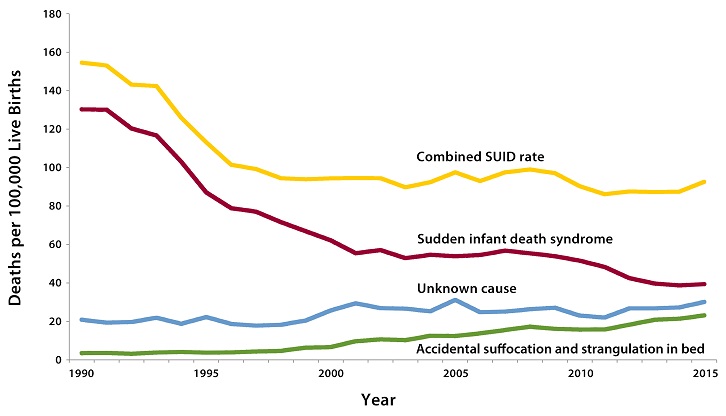
Our infant son is celebrating his half birthday! An entire six months has passed in the blink of an eye as we watched our little dude grow, practically overnight. A half birthday is a big deal in a baby's life — by six months, most babies have developed a set of social and language skills, have fine-tuned their motor skills, can sit up with little or no support, may roll in both directions, and start dabbling in the world of solid foods. And, perhaps most important of all, the risk of Sudden Infant Death Syndrome (SIDS) drops significantly. Babies who are six months and older are thought to have a lower risk of SIDS, in part due to muscle strength that allows them to lift their heads should they roll over from back to belly while asleep, avoiding suffocation.
SIDS is part of a larger category of Sudden Uncategorized Infant Deaths" (SUID). This includes accidental suffocation and strangulation in bed, in addition to deaths of unknown causes. The rate of SIDS deaths started to fall in the early 1990s with the implementation of the "Back to Sleep" campaign (now known as the "safe to sleep" campaign.) Still, the combined rates have plateaued in recent years, with cases of strangulation and suffocation while sleeping slightly increasing.
Source: CDC/NCHS, National Vital Statistics System, Compressed Mortality File
Aside from suffocation and strangulation which are responsible for 25 percent of all sleep-related deaths, other causes of SIDS remain somewhat of a mystery to scientists and parents. But in recent years, much research has explored neurological variants, like serotonin levels in the brain, and a gene variant that could provide some insight. Here's what scientists know so far:
The SCN4A gene belongs to a family of genes that is responsible for making sodium channels. The channels play a key roll in a cell's ability to transmit positively charged sodium atoms into cells, thus allowing cells to generate and transmit electrical signals. In the body, these signals are needed in order for muscles to contract and relax in a coordinated way.
This type of inherited neuromuscular disorder is rare, affecting one in 100,000. In a recent small-case study, a disruptive SCN4A gene was more often seen in infants who died from SIDS. Four of 278 infants who died from SIDS had a functionally disruptive SCN4A variant, according to findings reported by Roope Männikko, MD, of University College London (UCL), and colleagues.
In the findings, the authors explain that disruptions in the gene, also referred to as Nav1.4, can cause various degrees of 'respiratory compromise,' which can be life-threatening. They argue that the gene may be present in infants who died of SIDS, though they caution that only a suggestive link has been found between the two thus far. More research is needed to clarify whether respiratory muscles are vulnerable to disruption in sodium channel functions, thus increasing the risk of SIDS.
An editorial by Stephen C. Cannon, MD, of the University of California Los Angeles describes the new findings as 'compelling,' writing in part:
"One clinical implication of this study is that pharmacotherapy with sodium channel blockers during the period of developmental risk could prevent SIDS, as these drugs can do for laryngospasm, stridor, and myotonia," he wrote. "Should we be more vigilant about monitoring for SIDS in infants with non-dystrophic myotonia? And are SIDS cases in this population under-reported?"
Serotonin levels and SIDS:
Research has shown that some cases of SIDS display abnormalities in serotonin regulation in the brain. The serotonergic neurons — located in the brain stem — play an important role in regulating breathing, among other things. Specifically, researchers from the Harvard Medical School (in collaboration with Boston's Children Hospital) found that one subtype is responsible for increasing breathing — in mice — when too much carbon dioxide builds up in the body: Egr2-Pet1 neurons. More research is needed to explore whether or not abnormalities in serotonergic neurons can provide an explanation for the risk of SIDS.
CDC recommendations
In 2016, the Centers for Disease Control and Prevention (CDC) unveiled its most comprehensive set of new guidelines to reduce the risk of SIDS in infants. Because of the slight increase in sleep-related deaths (accidental suffocation or strangulation in bed), the recommendations focus on safe sleeping habits, including always placing the child on its back to sleep, and using a firm mattress free of toys and blankets.




